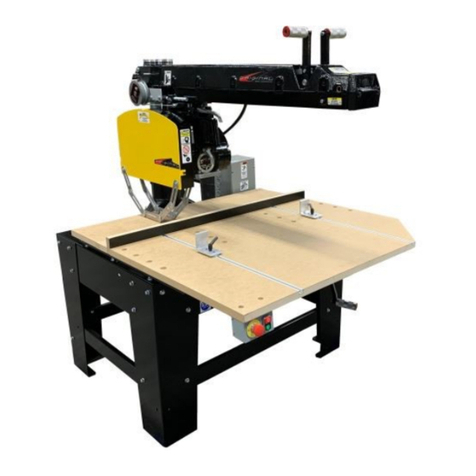
6
Modifications:
Any modifications to the machine including incorpora-
tion into an assembly, addition of integrated feeds or
other changes are the responsibility of the end user
and the end user must ensure ongoing compliance.
Additional Safety Actions to be Take by End
User
Lock out Tag out procedures to be adopted during all
maintenance.
Lock out Tag out procedures to be observed when
changing blade
Functional Testing
Braked run down times test—tested monthly
(20 second brake run down )
Upper Guard locking—tested monthly, prove there is
an inability to open upper guard without tools.
Test lower guards for hang ups make sure upper plas-
tic section drop down to cover blade
Test lower ring guard (inner) test to make sure it moves
freely, it is not bent, and does not hang up– must drop
freely to lower portion of blade
Instructions for Use:
• Always observe the safety instructions and applicable
regulations.
• Ensure the material to be cut is firmly secured in
place.
• Apply only a gentle pressure to the tool and do not
exert side pressure on the saw blade.
• Avoid overloading.
• Install the appropriate saw blade. Do not use exces-
sively worn blades. The maximum rotation speed of the
tool must not exceed that of the saw blade.
• Do not attempt to cut excessively small pieces.
• Allow the blade to cut freely. Do not force.
• Allow the motor to reach full speed before cutting.
• Make sure all locking knobs and clamp handles are
tight.
• Never run the machine without the guards in place.
• Never lift the machine by the table top.
Preventative Maintenance
Original Radial Arm Saws are designed to provide you
with precision cutting with a minimal amount of
maintenance. The frequency of the maintenance de-
pends on the amount of use and the desired cutting
quality.
Always disconnect and lockout power supply
before performing maintenance.
After every 160 hours of use, the column should
be wiped down with a clean, dry rag.
Wipe the tracks of the arm with a clean rag and
either denatured alcohol or paint thinner to remove
wood pitch buildup. Move the carriage back and
forth several times and clean it again. DO NOT
lubricate the arm tracks; doing so may cause ex-
cessive arm wear due to dust attracting to the arm
tracks.
Keep the tracks clean and dry.
Pull carriage from the arm and wipe bearings with
denatured alcohol or paint thinner.
Periodically wipe or vacuum sawdust from all ex-
posed surfaces. Check for loose or broken parts
and replace if necessary with genuine Original
Saw Parts. Check the blade to see if it is sharp
and free of wobble.
Adjustment and alignment of saw is necessary
only when cutting results in unacceptable accura-
cy.
After many years of use your saw may need re-
placement parts. If any of the following wears out,
all others listed should be checked also.
Roller head bearings: Check for free, smooth
rota- tion. Do not attempt to lubricate.
Arm Tracks: If the saw is used primarily for
short cut-offs, the tracks may wear making it difficult
to adjust the roller head bearing for full length
arm travel. Arms can generally be re-machined—
contact Original Saw for pricing and shipping
n structions.
Motor bearings: Check for free, smooth rota-
tion. Do not attempt to lubricate.
Elevating mechanism: Remove, clean and
lubri cate with type EP grease. Check for wear
between nut and jack screw. Replace assem-
bly if loose.



































